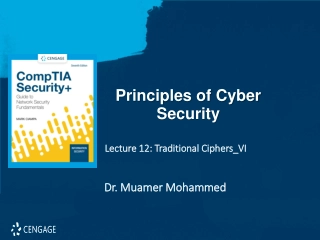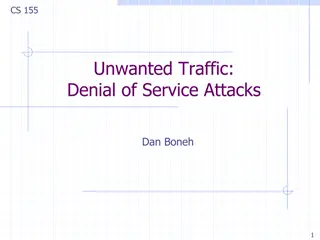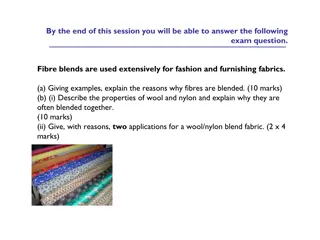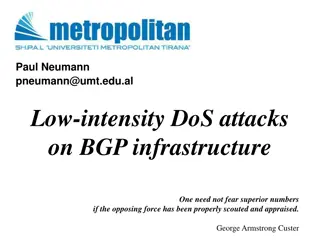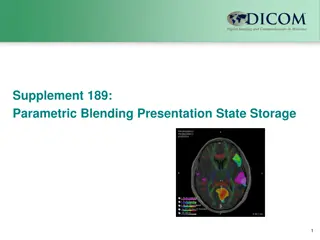Understanding Blending Attacks on Mixes by Meng Tang
Explore the effectiveness of blending attacks on mixes, including steps of a blending attack, attack models, factors affecting the attack, defense strategies, and insights from the attacker's viewpoint.
Download Presentation

Please find below an Image/Link to download the presentation.
The content on the website is provided AS IS for your information and personal use only. It may not be sold, licensed, or shared on other websites without obtaining consent from the author. Download presentation by click this link. If you encounter any issues during the download, it is possible that the publisher has removed the file from their server.
E N D
Presentation Transcript
Effectiveness of Blending Attacks on Mixes Meng Tang
Project Topics Steps of a blending attack Attack model Attack effectiveness Anonymity set size, chance of success, etc. Factors affecting the attack Ways to defend
blending attack Block incoming traffic good Mix good target good
blending attack good Block incoming traffic good bad good Flush legitimate messages bad bad Mix bad target bad
blending attack good Block incoming traffic good bad good Flush legitimate messages Insert target message bad bad Mix bad bad target
blending attack good Block incoming traffic good bad good Flush legitimate messages Insert target message Flush target message bad Mix bad bad bad bad target
blending attack Pool flushing Flush the memory of the mix Target flushing Flush the target message
From the attackers point of view What is important Number of non-spurious messages left in mix Determines anonymity set size Mix batching strategy and parameter Determines difficulty to flush a message, affects time consumption What is irrelevant Spurious messages Purely for the purpose to flush a mix Timed/threshold Attacker can make a threshold (pool) mix behave like a timed (pool) mix
Transform a threshold pool mix into a timed pool mix Threshold pool mix Pool size: N (possibly 0) Threshold: h Attacker Inserts spurious message at a constant rate f Mix behaves like a timed pool mix Pool size: N T=h/f
Description of mixes Ignore threshold mixes, consider all mixes to operate on a timed basis Define a mix with a set ??and a function ?(?) ??: a subset of real numbers ?(?): if a message ? is in the mix at time ?0and ?0 ??, then ?(?) is the possibility that ? remains in the mix at time ?0+ ? ? ?is dependent on the mix s settings and the attacker s computing power
Attack on timed mix Mix fires at ?0 Attacker blocks incoming traffic at time ?0 Attacker waits until ?1, inserts target message Attacker waits until ?2, selects one message from output, claims equivalency ??= {? | ? = ?0+ ??,? ?} ? ? = 1 0 ? < ? ? T 0 ?1= ?0+ ? ?2= ?0+ 2?
Attack on timed pool mix Same steps as timed mix ?: pool size ?: number of spurious messages attacker inserts each round ? = ? ?+?, indicates the rate that the pool shrinks ? : number of legitimate messages left in mix at ?1 ??= {? | ? = ?0+ ??,? ?} ? ? = ?? ?? ? < ? + 1 T,? ? ? ? = ??? ? ? ?1= ?? ?2= ? ? ? ? ? ?,? > ?
Attack on binomial mix Same steps as timed mix ?: number of messages left in the mix at ?0 ?: the chance that the a message is not fired, in each round ? : number of legitimate messages left in mix at ?1 ??= {? | ? = ?0+ ??,? ?} ? ? = ?? ?? ? < ? + 1 T,? ? ? ? = ??? ? ? ?1= ?? ?2= ? ? ? ? ? ?,? > ?
Simplifying assumption A smart attacker never stops attack between mix fires Either stops at the previous mix fire (saves time) Or stops at following mix fires (better results) Values of ? ? between mix fires are do-not-care terms Redefine ? ? for timed pool mix and binomial mix ? ? = ?? Extend ? ? ? = ??,? ? ? ? =?? ? 0
Analysis anonymity set size Assume that the mix may output any message at any time The attacker blocks all incoming traffic at ?0, inserts target message at ?1, and terminates the attack at ?2 ?: number of non-spurious messages in mix at ?0 ? : number of non-spurious messages in mix at ?1 ? ? = ?? ?1 ?0 ?? = 1 + ?
Analysis effectiveness evaluation If the attacker has limited time, then there is a chance that there re no message output between ?1 and ?2 ??= (? ?2 ?1)|??| Attacker s overall chance of success 1 ?? |??|=1 (? ?2 ?1)|??| ??= |??|
Analysis message delay Mix has message delay of ? + ?? ? 1 ? ?? + ?? ? ? 0 ?? = ? 0 ?=0 + ?? ? ?? ? ? = ?=0 = ?=0 Because ? ? depends on the attacker, ? is not the actual message delay when the mix is in normal operation ,but should be proportional to it.
Analysis exact/certain attack The attack is exact if ?? = 1 (attacker may spend infinite time) The attack is exact and certain if ?? = 1, and ??= 0 (attacker spends finite time) ?? = 1 + ?? ?1 ?0, ??= (? ?2 ?1)|??| The attack can be exact and certain iff for some ?, ? ? = 0. Because ? ? is monotonically decreasing, there is a value ????such that for any ? > ????, ?(?) = 0 ? + ?(?) = 0 should always hold, or there is a positive chance for each message to lim stay in the mix indefinitely. So an exact attack is always possible (if no other mechanics are introduced)
Example ? ? =? ?? Plot of ?? as a function of ? ? > 0
Example Plot of ?? as a function of ? ?
Mixes that utilize dummy message First proposed by Danezis and Sassaman [11] as Heartbeat Traffic 1 ?? |??|=1 (? ?2 ?1)|??| ??= |??| Since lim ? + ?(?) = 0 , there is little we can do with ?? Idea: put an upper bound to ?? by setting a lower limit for |??| |??| is reduced to 1 if no good messages other than the target is in the mix Construct a source of non-spurious messages that never depletes dummy pool
Mixes that utilize dummy message Mix maintains a pool of dummy messages of pool size ?? Messages in the dummy pool are treated the same way as normal messages, and also follows the function ? ? Each time a dummy messages is fired, the dummy pool is refilled to ?? Dummy messages are sent to random recipients Dummy pool can be made virtual if dummy messages are generated on the fly As long as ? ? does not change, normal traffic is not affected Anonymity set size is increased ?? = ??+ 1 + ?? ?1 ?0
Example Plot of ?? as a function of ? ? ??= 10
Traffic overhead ?: traffic incurred by dummy messages ?: normal traffic ?: number of messages in mix when the mix is in steady state (pool size) = ??? 0 ?? ? ? ?? = ??1 ? ?? = ??? 0 ? ?? = ?? 0 ?? ??? = ? 1 ? ?? = ? ? 0 ? ?? ?(?) ? =?? ? If ? is large, the dummy pool can decrease ?? without imposing too much impact on the outgoing traffic
references [1] Andreas Pfitzmann, Michael Waidner, Networks Without User Observability , in Computers and Security, 1987, pp. 158-166 [2] Brian N. Levine, Michael K. Reiter, Chenxi Wang, Matthew Wright, Timing Attacks in Low-Latency Mix Systems , in Financial Cryptography, 2004, pp. 251-265 [3] Claudia Diaz, Andrei Serjantov, Generalising Mixes , in Privacy Enhacing Technologies [4] David Chaum, Untraceable electronic mail, return addresses, and digital pseudonyms , in Communications of the ACM, 1981 [5] David M. Goldschlag, Michael G. Reed, Paul F. Syverson, Hiding Routing Information , in Proceedings of the First International Workshop on Information Hiding, 1996, pp. 137-150 [6] George Danezis, Designing and attacking anonymous communication systems , (UCAM-CL-TR-594) [7] Luke O'Connor, On Blending Attacks For Mixes with Memory Extended Version , in 7th International Workshop, 2005, pp. 39-52 [8] Oliver Berthold, Andreas Pfitzmann, Ronny Standtke, The disadvantages of free MIX routes and how to overcome them , in Proceedings of Designing Privacy Enhancing Technologies: Workshop on Design Issues in Anonymity and Unobservability, pp. 30-45 [9] Parvathinathan Venkitasubramaniam, Venkat Anantharam, On the Anonymity of Chaum Mixes , in Proceedings 2008 IEEE international symposium on information theory, 2008, pp. 534-538 [10] Claudia Diaz, Bart Preneel, Reasoning about the Anonymity Provided by Pool Mixes that Generate Dummy Traffic , in Information Hiding: 6th International Workshop, 2004, pp. 309-325 [11] George Danezis, Len Sassaman, Heartbeat Traffic to Counter (n-1) attacks , in Proceedings of the 2003 ACM workshop on Privacy in the electronic society, 2003, pp. 89-93





